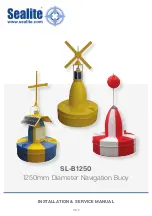
Page 616
CHAPTER 6
May/12
9107
SERVICE MANUAL
Page 616
Feb/11
CHAPTER 6
283
SERVICE MANUAL
ISO 9650
(d) While holding the valve on the inside, use a calibrated torque
wrench and the correct adaptor tools, to tighten the valve from
the outside. Please refer to Chapter 1, TABLE 101 for torque
settings value.
WARNING:
ONLY THE TORQUE VALUE SPECIFIED SHOULD BE APPLIED.
WHEN THE CORRECT TORQUE IS ACHIEVED FOR THE FIRST
TIME, THE VALVE MUST NOT BE TIGHTENED AGAIN. IF RE-
TIGHTENING IS NECESSARY A COMPLETE NEW VALVE MUST
BE FITTED.
(e) The slit must then be repaired as detailed in this Chapter.
CAUTION:
ENSURE THE VALVE CAP(S) HAVE BEEN REMOVED
BEFORE INFLATION.
(f) After waiting the required time for the repair to cure please
complete and record an air-holding test as described in Chapter
5.
6.3 Inf ation valve
Leaf
i
eld type (FIGURE 606)
6.3.1 The inf
l
ation valves have different jet bores, as stated below. The
size of the jet bore is stamped in the f
l
at surface of the valve body.
The stamp also shows the direction of the jetholes.
(a) The bore size for the lower buoyancy is 2.2 mm.
(b) The bore size for the upper buoyancy is 2.8 mm.
6.3.2 There is only one size of hose for this valve.
6.3.3 The assembly requires an aperture of 24 mm diameter in the
buoyancy chamber. The aperture is reinforced at this point.
(a) Def
l
ate the liferaft for this repair.
(b) To install an inf
l
ation valve access to the inside of the buoyancy
chamber is required. This is achieved by making a slit in the
buoyancy, approximately 150 mm (6 in) long.
(i) The slit is required close to the inlet valve position.































